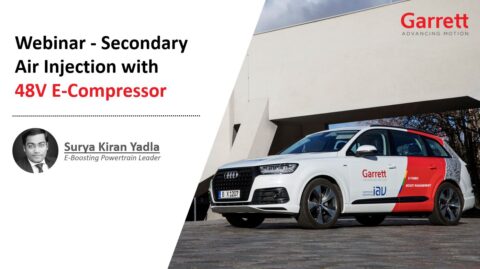Accessing the Knowledge Center effectively requires a simple, one-time registration.
Performance & Reliability
How a Turbo Works - Basic Guide
By installing a Garrett turbocharger, the power and performance of an engine can be dramatically increased. Please also see our expert and advanced guides of how turbo works.
How a Turbo System Works
Engine power is proportional to the amount of air and fuel that can get into the cylinders. All things being equal, larger engines flow more air and as such will produce more power. If we want our small engine to perform like a big engine, or simply make our bigger engine produce more power, our ultimate objective is to draw more air into the cylinder. So how does a turbocharger get more air into the engine? Let us first look at the schematic below:
1 Compressor Inlet 2 Compressor Discharge 3 Charge air cooler (CAC) 4 Intake Valve 5 Exhaust Valve 6 Turbine Inlet 7 Turbine Discharge

How a Turbo System is made up
The components that make up a typical turbocharger system are:
- The air filter (not shown) through which ambient air passes before entering the compressor (1)
- The air is then compressed which raises the air’s density (mass / unit volume) (2)
- Many turbocharged engines have a charge air cooler (aka intercooler) (3) that cools the compressed air to further increase its density and to increase resistance to detonation
- After passing through the intake manifold (4), the air enters the engine’s cylinders, which contain a fixed volume. Since the air is at elevated density, each cylinder can draw in an increased mass flow rate of air. Higher air mass flow rate allows a higher fuel flow rate (with similar air/fuel ratio). Combusting more fuel results in more power being produced for a given size or displacement
- After the fuel is burned in the cylinder it is exhausted during the cylinder’s exhaust stroke in to the exhaust manifold (5)
- The high temperature gas then continues on to the turbine (6). The turbine creates backpressure on the engine which means engine exhaust pressure is higher than atmospheric pressure
- A pressure and temperature drop occurs (expansion) across the turbine (7), which harnesses the exhaust gas’ energy to provide the power necessary to drive the compressor

1. Ball Bearings (support and control the rotating group)
2. Oil Inlet
3. Turbine Housing (collects exhaust gases from the engine and directs it to the turbine wheel
4. Turbine Wheel (converts exhaust energy into shaft power to drive the compressor)
5. Center Housing (supports the rotating group)
6. Oil Outlet
7. Compressor Housing (collects compressed air and directs it to the engine)
8. Compressor Wheel (pumps air into the engine)
9. Backplate (supports the compressor housing provides aero surface)
Performance & Reliability
What are the components of a turbocharger?
The layout of the turbocharger in a given application is critical to a properly performing system. Intake and exhaust plumbing is often driven primarily by packaging constraints.
Blow-Off Valves
The Blow-Off valve (BOV) is a pressure relief device on the intake tract to prevent the turbo’s compressor from going into surge. The BOV should be installed between the compressor discharge and the throttle body, preferably downstream of the charge air cooler (if equipped).
Learn more by downloading our guide:

Turbo Wastegates
On the exhaust side, a Wastegate provides us a means to control the boost pressure of the engine. Some commercial diesel applications do not use Wastegates at all. This type of system is called a free-floating turbocharger.
However, the vast majority of gasoline performance applications require a Turbo Wastegate. There are two (2) configurations of Wastegates, internal or external.
Both internal and external Wastegates provide a means to bypass exhaust flow from the turbine wheel. Bypassing this energy (e.g. exhaust flow) reduces the power driving the turbine wheel to match the power required for a given boost level.
Similar to the BOV, the Wastegate uses boost pressure and spring force to regulate the flow bypassing the turbine.


Internal
Wastegates are built into the turbine housing and consist of a “flapper” valve, crank arm, rod end, and pneumatic actuator. It is important to connect this actuator only to boost pressure; i.e. it is not designed to handle vacuum and as such should not be referenced to an intake manifold.

External
Wastegates are added to the exhaust plumbing on the exhaust manifold or header. The advantage of an external Wastegate is that the bypassed flow can be reintroduced into the exhaust stream further downstream of the turbine. This tends to improve the turbine’s performance. On racing applications, this Wastegate exhaust flow can be vented directly to atmosphere.
Oil and Water Plumbing
The intake and exhaust plumbing often receives the focus leaving the oil and water plumbing neglected. Garrett ball bearing turbochargers require less oil than journal bearing turbos. Learn more by downloading our guide:

Which Turbocharger is Right for Me
Selecting the proper turbocharger for your specific application requires many inputs. With decades of collective turbocharging experience, the Garrett Performance Distributors can assist in selecting the right turbocharger for your application.
The primary input in determining which turbocharger is appropriate is to have a target horsepower in mind. Learn more by downloading our guide:

Journal Bearings vs. Ball Bearings
The journal bearing has long been the brawn of the turbocharger, however a ball-bearing cartridge is now an affordable technology advancement that provides significant performance improvements to the turbocharger. Learn more by downloading our guide:
















